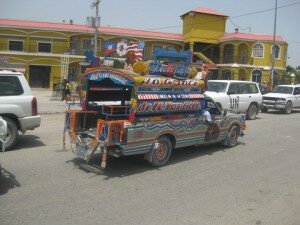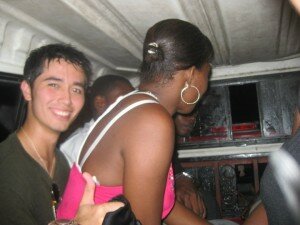Tap Taps, Volunteering in Haiti, part two
 by Veronique Parages, Skills-Based Volunteer Program Director, HandsOn Network
by Veronique Parages, Skills-Based Volunteer Program Director, HandsOn Network
The “tap-tap” is the common system of transportation.
One trip is 5 gouds, one goud is a Haitian dollar, a $ dollar is 40 gouds.
It sounds easy but you try learning to pay for your rides in Haiti.
Trips around Port Au Prince are not expensive, but they are always interesting.
No one uses signals and most of the drivers don’t actually have a license to drive because it is too expensive.
The streets are colorful with Christian messages in orange, yellow, red, looking as old as the many pick up trucks with low tires.
Many of the pick ups have a make-shift roof to protect the passengers from the sun, wind and dust.
 “Tap-tap” is the noise of the passengers’ heads knocking on the roof, the sound of their shoulders and arms hitting the metal borders of the truck bed or their neighbor’s body. It is also the noise of knocking on the roof or the window of the front seats to let the driver know that one of the passengers wants to stop.
“Tap-tap” is the noise of the passengers’ heads knocking on the roof, the sound of their shoulders and arms hitting the metal borders of the truck bed or their neighbor’s body. It is also the noise of knocking on the roof or the window of the front seats to let the driver know that one of the passengers wants to stop.
The two benches along the back of the pick up can fit 6 people each… o0ps sorry make that 7… no 8! (and sometimes more).
Just squeeze, squeeze, squeeze!
I see kids in uniforms, people dressed up to go to work, women going to sell or to buy at flea market with huge bags full of chicken (some live) or vegetables or water to cook.
Everyone travels using the tap-tap system! And so do we… a 1 to 2 hours commute time every day back and forth to our volunteer project.
We have to take three consecutive tap-taps to arrive at the feeding center where we volunteer — and it is so worth it!!!
A tap-tap ride is a colorful piece of Haiti. Everyone helps everyone else.
 People give you a hand to catch a moving tap-tap still, find places for the pregnant women to sit, hold children on laps, hold a neighbor’s bag, pass on the money and the change, hold you and catch you if you are standing half bent over in between seated people under the low roof losing your balance at each pothole.
People give you a hand to catch a moving tap-tap still, find places for the pregnant women to sit, hold children on laps, hold a neighbor’s bag, pass on the money and the change, hold you and catch you if you are standing half bent over in between seated people under the low roof losing your balance at each pothole.
The Haitian people have been welcoming and friendly to the strange animals that we are, especially the white skin ones like me, look funny and stand out here.
Sometimes very young children show me to their parents.
I find that a smile and a big” Bonjour” get’s all the passengers smiling back. They begin to talk, shy first and then more, in French or trying in English. It’s a perfect way to discover the Haitian’s day today’s lives.
Christian messages are everywhere, on the tap-taps as decoration, as well as in the names of shops and in Haitian’s hearts.
Some passengers read the bible in the tap-taps.
Children in uniforms go to private religious schools when they can afford it. –70 to 80% of public schools have been destroyed by the earth quake around Port-Au-Prince.
The poorest accept their misery and the earthquake as the will of God.
But is it?
Can all the small church networks help people create local projects and local jobs instead of organizing long days of prayers? Or can they do both?
 I know it is easy to say and not to do, but talking to the kids, to the students, to the youth in the tap-taps gives me the feeling that if somebody believes in their country and its resources, the Haitians may believe in it again too… How can we help?
I know it is easy to say and not to do, but talking to the kids, to the students, to the youth in the tap-taps gives me the feeling that if somebody believes in their country and its resources, the Haitians may believe in it again too… How can we help?
If Rwanda has been able to rebuild their country, to reunify two populations with respect and solidarity to each other despite years of horrible genocide, maybe Haiti can take the earth quake as a catalyst to reunify rich and poor, to create synergy and actions plans, to re-launch agriculture and exports and begin tourism?
I really hope so.
We need to continue to help them do it…


